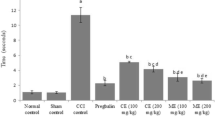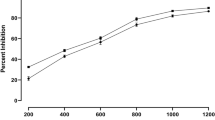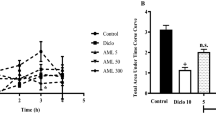Abstract
The aim of present study was to evaluate effect of lyophilized extract of Tridax procumbens Linn. in rodent models of inflammatory and neuropathic pain. The antiallodynic and antihyperalgesic activity of Tridax procumbens was assessed in Chronic Constriction Injury of Sciatic Nerve in rats (CCI) and Scald pain model in rats (burning pain) respectively at 100,200 and 400 mg/kg, p.o. In CCI model, the extract shows the dose dependent antiallodynic activity 60 min. post dose. In Scald pain model, extract shows the significant antihyperalgesic activity at 200 and 400 mg/kg at 60 and 90 min. post dose. The lyophilized extract of Tridax procumbens was found to be effective in neuropathic and inflammatory pain, suggesting its possible action via peripheral mechanisms. The activity may be attributed to the presence of flavonoids such as Quercetin.
Similar content being viewed by others
References
Ali M, Earla R, Ramidi R (2001) A new flavonoid from the aerial parts of Tridax procumbens. Fitoterapia 72:313–315
Bennett GJ, Xie YK (1988) A peripheral mononeuropathy in rat that produces disorders of pain sensation like those seen in man. Pain 33:87–107
Bhat RS, Shankrappa J, Shivakumar HG (2007) Formulation and evaluation of polyherbal wound treatments. Asian J Pharm Sci 2(1):11–17
Bridges D, Thompson SWN, Rice ASC (2001) Mechanism of neuropathic pain. Br J Anaesth 87(1):12–26
Diwan PV, Karwande I, Margaret I, Sattur PB (1989) Pharmacology and biochemical evaluation of Tridax procumbense on inflammation. Ind J Pharmacol 21:1–7
Edeoga HO, Okwu DE, Mbaebie BO (2005) Phytochemical constituents of some Nigerian medicinal Plants. Afr J Biotech 4:685–688
Gupta S, Kulhara P (2007) Cellular and molecular mechanisms of drug dependence: an overview and update. Indian J Psychiatry 49(2):85–90
Hamura H, Yoshida M, Shimizu K, Matsukra T, Suzuki H, Narita M, Suzuki T (2004) Anti-nociceptive effect of combination of Pentazocine with morphine in the tail immersion and Scald pain test in rats. Jpn J Pharmacol 83:286–292
Ikewuchi JC (2012) An aqueous extract of the leaves of Tridax procumbens Linn (Asteraceae) protected against carbon tetrachloride induced liver injury in Wistar rats. Pac J Sci Technol 13:519–527
Joshi UJ, Gadge AS, D’Mello P, Sinha R, Srivastava S, Govil G (2011) Anti-inflammatory, antioxidant and anticancer activity of Quercetin and its analogues. Int J Res Pharm Biomed Sci 2(4):1756–1766
Kokate CK, Purohit AP, Gokhale SB (2004) Pharmacognosy. Nirali Prakashan, India, p 101
Narenjkar J, Roghani M, Alambeygi H, Sedaghati F (2011) The effect of the flavonoid Quercetin on pain sensation in diabetic rats. Basic Clin Neurosci 2:51–57
Nia R, Paper DH, Essien EE, Oladimeji OH, Iyadi KC, Franz G (2003) Investigation into in-vitro radical scavenging and in-vivo anti-inflammatory potential of Tridax procumbense. Niger J Physiol Sci 18:39–43
Oladunmoye MK (2006) Immunomodulatory effects of ethanolic extract of Tridax procumbense on Swiss Albino Rats orogastrically dosed with Psedomonas aeruginosa(NCIB 950). Acad J Inc Trends Med Res 1(2):122–126
Pathak AK, Saraf S, Dixit VK (1991) Hepatoprotective activity of Tridax procumbens—part I. Fitoterapia 62:307–313
Rakesh SU, Patil PR, Salunkhe VR, Dhabale PN, Burade KB (2009) HPTLC method for quantitative determination of Quercetin in hydroalcoholic extract of dried flower of Nymphaea stellata willd. Int J ChemTech Res 1(4):931–936
Raygude KS, Kandhare AD, Ghosh P, Ghule AE, Bodhankar SL (2012) Evaluation of ameliorative effect of Quercetin in experimental model of alcoholic neuropathy in rats. Inflammopharmacology 20:331–341
Salahdeen HM, Yemitan OK, Alada AR (2004) Effect of aqueous leaf extract of Tridax procumbense on blood pressure and heart rate in rats. Afr J Biomed Res 7:27–29
Tandrup T, Woolf CJ, Coggeshall RE (2000) Delayed loss of small dorsal root ganglion cells after transection of the rat sciatic nerve. J Comp Neurol 422:172–180
Vilwanathan R, Kanchi SS, Thiruvengadam D (2005) Hepatoprotective activity of Tridax procumbens against d-galactosamine/lipopolysaccharide-induced hepatitis in rats. J Ethnopharmacol 101:55–60
Yadava RN, Kumar S (1998) A new flavone glycoside: 5,7,4′-Trihydroxy-6,3′-Dimethoxy Flavone 5-O-α-L-Rhamnopyranoside from the leaves of Tridax procumbens Linn. J Asian Nat Prod Res 1:147–152
Acknowledgments
We would like to thank Jubilant Biosys Ltd, Drug Discovery Center Bangalore, India for providing the necessary facilities to carry out the research.
Author information
Authors and Affiliations
Corresponding author
Rights and permissions
About this article
Cite this article
Sawant, S., Chine, V., Kalange, A. et al. Evaluation of lyophilized extract of leaves of Tridax procumbens Linn. in rodent models of inflammatory and neuropathic pain. Orient Pharm Exp Med 14, 163–167 (2014). https://doi.org/10.1007/s13596-013-0143-1
Received:
Accepted:
Published:
Issue Date:
DOI: https://doi.org/10.1007/s13596-013-0143-1




